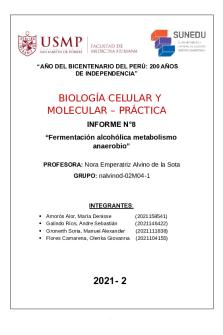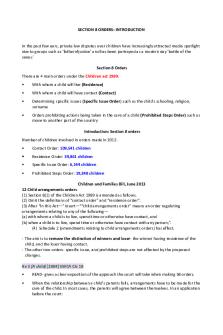META S8 Handout Post-Reading Questions Completed PDF

| Title | META S8 Handout Post-Reading Questions Completed |
|---|---|
| Author | Ciara alaysia |
| Course | Cell Biology |
| Institution | Texas Southern University |
| Pages | 2 |
| File Size | 87 KB |
| File Type | |
| Total Downloads | 78 |
| Total Views | 116 |
Summary
shjshhsjlhwheqkjhhedjjedn...
Description
“A Very Old Man with Enormous Wings” Post-Reading Questions 1. H ow does the author introduce the superstitious nature of the characters in the first paragraph? In the first paragraph, the characters believe the baby’s fever is due to the smell from all the crabs coming into the sea. All the rain is also described as “The world” being “sad since Tuesday.” 2.
What is the impact of the language used to describe the old man that Pelayo finds in the mud?
The author uses unappealing, and unsavory language to describe what should be considered a wondrous being. The old man has “a few faded hairs left on his bald skull and very few teeth in his mouth” and is compared to a “drenched great-grandfather.” His wing are “huge buzzard wings, dirty and half-plucked” and covered in mud. The less than celestial descriptions inject realism into what would normally be a character of fantasy. 3.
How do the neighbor woman’s conclusions about the winged old man advance the plot?
The couple’s neighbor declares the man to be an angel coming for the baby, but the couple does not have the heart to kill the him. This declaration leads to the interest of the town and the inquisitions of Father Gonzaga. 4.
How does Father Gonzaga attempt to verify that the “angel” is not an “imposter”? What do these tests indicate about the religious nature of the people?
Father Gonzaga speaks to the “angel” in Latin, but the old man doesn’t know “the language of God” or how to address religious leaders. The priest also evaluates the old man’s physical appearance as ”much too human: he had an unbearable smell of the outdoors”, considering him beneath “the dignity of angels.” He does write to the Pope for confirmation, though. This indicates that these people believe religion to be a formalized institution governed by superiors who declare what is sacred and what is not. It also forces the people to confront their ideas about what an angel is and how they handle things that don’t measure up to their beliefs. 5.
What does Elisenda and Pelayo and their neighbor’s treatment of the old man indicate about their values?
Elisenda and Pelayo decide to charge an entrance fee to view the old man. The townspeople come to visit “the angel” as if he were a “circus animal” and invalids come to try to get healthy. Everyone appears to “want something” from the visitor and no one seems concerned at all about his well-being or the meaning for his visit. Even those that believe he is an “angel” are not moved to be more religious or kind to others. 6.
Why do the townspeople prefer the “spectacle” of the spider-woman? What does this indicate about them?
The townspeople prefer the “human truth” and the “fearful lesson.” This indicates that they want a straight-forward message and would rather be ruled by fear than to interpret ideas.
Grade 10: The Metamorphosis
7. What changes occur in does Elisenda and Pelayo’s living situation? What changes occur in the old man’s living situation? As Elisenda and Pelayo’s living situation improves because of all the money they gained from the admission, the living conditions of the old man deteriorate. 8.
Why does Elisenda let out a sigh of relief “for herself and for him”?
Elisenda is relieved that the old man is able to fly away for him, but mostly for herself. She has had to bear the existence of this being around her home for too long. Instead of generating compassion, the old man generated greed in the characters and once he had served his purpose, they were glad to be rid of him.
Grade 10: The Metamorphosis...
Similar Free PDFs

La meta
- 2 Pages

Mercado meta
- 4 Pages

Mercado Meta
- 3 Pages

Meta 2
- 2 Pages

S8 orders family law
- 15 Pages

8-causatives (s8)
- 2 Pages

Meta-Code of Ethics - -----
- 6 Pages

PP-Cultura-Meta - ddff
- 212 Pages

Informe S8 Informatica
- 3 Pages

Estadística D. Ejercicios s8
- 2 Pages

Informe S8 - Biología PRA
- 5 Pages

S8 orders - contact & residence
- 20 Pages

Informe S8 Histologia PRÁC
- 8 Pages
Popular Institutions
- Tinajero National High School - Annex
- Politeknik Caltex Riau
- Yokohama City University
- SGT University
- University of Al-Qadisiyah
- Divine Word College of Vigan
- Techniek College Rotterdam
- Universidade de Santiago
- Universiti Teknologi MARA Cawangan Johor Kampus Pasir Gudang
- Poltekkes Kemenkes Yogyakarta
- Baguio City National High School
- Colegio san marcos
- preparatoria uno
- Centro de Bachillerato Tecnológico Industrial y de Servicios No. 107
- Dalian Maritime University
- Quang Trung Secondary School
- Colegio Tecnológico en Informática
- Corporación Regional de Educación Superior
- Grupo CEDVA
- Dar Al Uloom University
- Centro de Estudios Preuniversitarios de la Universidad Nacional de Ingeniería
- 上智大学
- Aakash International School, Nuna Majara
- San Felipe Neri Catholic School
- Kang Chiao International School - New Taipei City
- Misamis Occidental National High School
- Institución Educativa Escuela Normal Juan Ladrilleros
- Kolehiyo ng Pantukan
- Batanes State College
- Instituto Continental
- Sekolah Menengah Kejuruan Kesehatan Kaltara (Tarakan)
- Colegio de La Inmaculada Concepcion - Cebu


